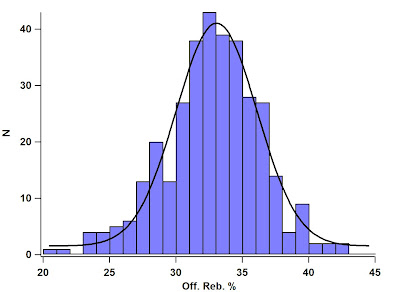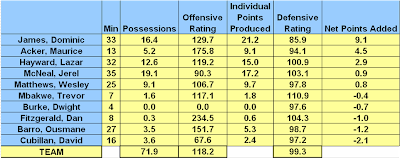Let's run the numbers:
TEMPO-FREE BOX SCORE
. Visitor Home
. GU Maryland
. 1st Half 2nd Half Total 1st Half 2nd Half Total
Pace 30 33 63
Effic. 126.2 111.4 118.4 66.4 84.3 75.8
eFG% 60.0 60.4 60.2 36.0 32.8 34.2
TO% 19.9 30.1 25.3 26.6 15.1 20.5
OR% 46.2 45.5 45.8 22.2 39.1 31.7
FT Rate 40.0 50.0 44.9 12.0 28.1 21.1
Assist Rate 69.2 38.5 53.8 37.5 30.0 33.3
Block Rate 11.1 9.5 10.3 25.0 0.0 13.8
Steal Rate 3.3 6.0 4.7 0.0 3.0 1.6
2FG% 56.2 76.9 65.5 33.3 42.9 38.5
3FG% 44.4 27.3 35.0 28.6 9.1 16.7
FT% 80.0 66.7 72.7 66.7 77.8 75.0
The game was certainly played at the Hoyas' pace - this was the slowest game of the year for Georgetown, 2 possessions slower than the slog against WSU.
The first half was a defensive clinic for Georgetown. The Terrapins struggled greatly on 2-pt shots (33.3%) and couldn't corral many of their misses (4 OR's on 18 available misses). The Terps also turned the ball over on more than 1 in 4 possessions, although the low Hoya steal rate (3.3%) indicates that many of Maryland's TOs were self-inflicted.
Meanwhile, the Hoyas made 4-9 3FGs in the half, led by J. Sapp's 2/3 3FG shooting, crashed the offensive glass (6/13 available missed shots) and finally kept their turnover rate below 20% for the first time in a half since Drexel.
Now to be fair, Maryland came into the game well-regarded on defense, but not particularly strong offensively, except for a low TO Rate and good FT shooting. The Terps managed only 3 FTA in the 1st half, so even extraordinary marksmanship from the stripe would have been no help.
The 2nd half was more of the same, as the Hoyas eventually stretched the lead out to 73-38 at the under-8:00 media timeout before the game devolved into garbage time. The end of the bench managed to turn the ball over in 7 out of the last 12 possessions, which will certainly give JTIII something to work on before next weekend's game against American.
One further point - something that I will continue to point out so long as G'town keeps it up - the Hoyas made 2/3 2-pt jumpers in the game, while the Terps made only 6/24 2-pt jumpers.
INDIVIDUAL NET POINTS STATS
GU Off Poss Individ Def Individ
Player Poss Used ORtg Pts Prod Poss DRtg Pts Allow Net Pts
Summers, DaJuan 26 8.2 135.7 11.1 26 50.6 2.6 +8.4
Freeman, Austin 46 9.4 178.1 16.7 45 73.8 6.6 +10.1
Monroe, Greg 43 8.4 133.3 11.2 42 74.5 6.3 +4.9
Wright, Chris 50 7.6 126.5 9.6 48 72.5 7.0 +2.7
Sapp, Jessie 35 9.0 106.9 9.6 37 51.6 3.8 +5.8
Mescheriakov, Nikita 19 4.2 9.3 0.4 19 69.4 2.6 -2.2
Jansen, Bryon 2 0.0 - 0.0 1 400.0 0.8 -0.8
Clark, Jason 38 5.3 102.0 5.4 39 78.8 6.1 -0.8
Vaughn, Julian 20 5.0 115.9 5.8 21 89.7 3.8 +2.1
Sims, Henry 16 1.0 200.0 1.9 16 95.0 3.0 -1.1
Wattad, Omar 20 3.0 0.0 0.0 21 88.9 3.7 -3.7
TOTALS 63 61.0 117.6 71.7 63 76.2 46.4 +25.3
Maryland Off Poss Individ Def Individ
Player Poss Used ORtg Pts Prod Poss DRtg Pts Allow Net Pts
MILBOURNE, Landon 39 8.7 55.0 4.8 40 118.9 9.5 -4.7
MOSLEY, Sean 42 4.9 83.7 4.1 43 137.2 11.8 -7.7
DUPREE, Braxton 33 6.0 69.1 4.1 33 125.6 8.3 -4.1
HAYES, Eric 48 7.0 118.4 8.2 48 99.9 9.6 -1.3
VASQUEZ, Greivis 41 9.8 41.6 4.1 40 151.2 12.1 -8.0
KIM, Jin-Soo 16 4.8 94.5 4.6 16 64.0 2.0 +2.5
BOWIE, Adrian 39 12.4 73.8 9.1 38 112.9 8.6 +0.6
PEARMAN, David 2 0.0 - 0.0 2 0.0 0.0 +0.0
TUCKER, Cliff 5 0.0 - 0.0 5 140.0 1.4 -1.4
BURNEY, Jerome 13 3.3 84.4 2.8 13 86.0 2.2 +0.5
GREGORY, Dino 15 4.0 58.2 2.3 15 90.7 2.7 -0.4
NEAL, Dave 22 1.0 243.8 2.5 22 103.8 4.6 -2.1
TOTALS 63 61.9 75.4 46.7 63 119.0 72.8 -26.2
J. Sapp had a nice 1st half offensively, but was quiet in the 2nd half, with only two missed FTs (thanks to Gary Williams' technical foul). However, his main assignment for the evening was to harrass G. Vasquez (1/3 2FG, 0/4 3FG), and the stats appear to have captured this, as he ended up with an excellent D. Rating for the game.
C. Wright played strong offensively through most of game, perfect on 2FGs (with some nice drives) and FTs, and only missing on his 2 3FG attempts. His stats are a bit suppressed by some sloppy play during garbage time, where he missed a 2FG and a committed a turnover. He'll need to practice his blowout-win offense this week.
D. Summers sat a bit with foul concerns in the 1st half, and was the first started to the bench as the game got out of hand in the 2nd half, so his possessions were limited. He was able to ride a hot outside shooting hand (3/5 3FG) to a nice offensive day, although at least one shot from inside the arc would have been nice. It will be interesting to see if Summers can return to his aggressive play from earlier in the tournament, or if his recent success from deep will encourage him to stay on the outside in the offense.
G. Monroe kept up his steady play for the fifth game in a row. His FT shooting will be something to keep an eye on (5/9 against Tennessee, 2/4 tonight). Yeah, that's about all I could come up with for a criticism.
And, the player of the game goes to . . . Austin Freeman, who was his usual ultra-efficient self on the offensive end. In addition to missing only 3 of 10 shots from the field, he also had 2 assists and 2 ORebs. He appears to be comfortably moving into the possession usage range of 20+% without any apparent drop-off in production.
Other players of note:
- J. Clark had the most possessions of the bench players tonight - he rebounded strongly, but was a bit careless with the ball (2 TOs / 5.3 poss used).
- J. Vaughn had a quietly nice offensive game
- O. Wattad came back down to earth after Friday's hot shooting
- H. Sims finally had a 100+ ORating game (made a lay-up, missed a 3FG, got an offensive rebound)
- N. Mescheriakov is still in search of his shooting touch, but I thought he looked more comfortable out there (that's something).
HD BOX SCORE
GU vs Maryland
11/30/08 5:30 p.m. at Lake Buena Vista, Fla. -- The Milk House
Final score: GU 75, Maryland 48
GU Min +/- Pts 2PM-A 3PM-A FTM-A FGA A Stl TO Blk OR DR PF
Summers, DaJuan 16:18 +26 14/43 0- 0 3- 5 5- 6 5/19 2/11 1/26 2/26 0/18 0/ 5 3/19 2
Freeman, Austin 28:58 +27 18/61 6- 8 1- 2 3- 3 10/38 2/14 0/45 1/46 0/27 2/19 4/25 2
Monroe, Greg 27:27 +29 12/59 5- 8 0- 0 2- 4 8/35 2/15 0/42 1/43 1/29 1/16 5/27 1
Wright, Chris 31:14 +23 8/62 3- 4 0- 2 2- 2 6/42 5/20 1/48 1/50 0/29 0/21 3/29 4
Sapp, Jessie 23:20 +35 10/57 1- 2 2- 3 2- 4 5/26 1/15 1/37 3/35 0/23 1/ 8 3/25 3
Mescheriakov, Nikita 11:45 - 4 0/11 0- 1 0- 1 0- 0 2/12 0/ 4 0/19 2/19 0/12 1/ 9 2/14 1
Jansen, Bryon 00:53 - 4 0/ 0 0- 0 0- 0 0- 0 0/ 0 0/ 0 0/ 1 0/ 2 0/ 1 0/ 0 0/ 1 0
Clark, Jason 23:59 + 6 5/36 1- 2 1- 3 0- 0 5/31 1/11 0/39 2/38 1/25 2/20 4/28 2
Vaughn, Julian 12:33 - 2 6/16 2- 3 0- 1 2- 3 4/14 1/ 4 0/21 1/20 1/10 1/ 9 1/14 2
Sims, Henry 09:58 - 5 2/10 1- 1 0- 1 0- 0 2/14 0/ 2 0/16 0/16 1/ 8 1/11 1/ 7 0
Wattad, Omar 13:35 + 4 0/20 0- 0 0- 2 0- 0 2/14 0/ 8 0/21 2/20 0/13 0/ 7 0/16 4
TOTALS 40:00 75 19-29 7-20 16-22 49 14/26 3/63 16/63 4/39 11/24 28/41 21
. 0.655 0.350 0.727 0.538 0.048 0.254 0.103 0.458 0.683
Maryland Min +/- Pts 2PM-A 3PM-A FTM-A FGA A Stl TO Blk OR DR PF
MILBOURNE, Landon 25:52 -18 3/32 1- 5 0- 2 1- 3 7/30 2/12 0/40 0/39 1/16 1/18 2/15 2
MOSLEY, Sean 28:31 -28 4/29 2- 5 0- 1 0- 0 6/35 0/10 0/43 1/42 1/19 1/24 0/16 2
DUPREE, Braxton 21:18 -18 6/24 3- 6 0- 0 0- 0 6/27 0/ 8 0/33 1/33 0/14 0/17 0/10 2
HAYES, Eric 29:28 -22 11/31 2- 3 1- 3 4- 4 6/43 0/ 8 1/48 3/48 0/26 0/34 3/23 0
VASQUEZ, Greivis 25:18 -30 2/31 1- 3 0- 4 0- 0 7/36 4/12 0/40 4/41 0/17 1/25 1/11 1
KIM, Jin-Soo 09:54 + 2 5/12 2- 2 0- 2 1- 1 4/15 0/ 2 0/16 1/16 0/ 8 1/11 0/ 7 1
BOWIE, Adrian 24:02 -10 11/34 3- 8 1- 4 2- 2 12/38 0/ 8 0/38 2/39 0/18 1/27 2/17 1
PEARMAN, David 01:31 + 4 0/ 4 0- 0 0- 1 0- 0 1/ 3 0/ 1 0/ 2 0/ 2 0/ 0 0/ 2 0/ 0 0
TUCKER, Cliff 03:57 - 2 0/ 5 0- 1 0- 0 0- 0 1/ 5 0/ 2 0/ 5 0/ 5 0/ 1 0/ 3 0/ 1 0
BURNEY, Jerome 08:02 - 2 2/12 1- 3 0- 0 0- 0 3/11 0/ 3 0/13 1/13 2/ 9 2/ 7 2/10 1
GREGORY, Dino 08:09 - 5 1/ 9 0- 2 0- 0 1- 2 2/17 0/ 2 0/15 0/15 0/ 8 3/16 1/ 6 2
NEAL, Dave 13:58 - 6 3/17 0- 1 1- 1 0- 0 2/25 0/ 4 0/22 0/22 0/ 9 2/21 1/ 9 3
TOTALS 40:00 48 15-39 3-18 9-12 57 6/18 1/63 14/63 4/29 13/41 13/24 15
. 0.385 0.167 0.750 0.333 0.016 0.222 0.138 0.317 0.542
Efficiency: GU 1.190, Maryland 0.762
eFG%: GU 0.602, Maryland 0.342
Substitutions: GU 23, Maryland 23
2-pt Shot Selection:
Dunks: GU 2-3, Maryland 1-1
Layups/Tips: GU 15-23, Maryland 8-14
Jumpers: GU 2-3, Maryland 6-24
I haven't gotten around to the team and individual stats pages yet after all, but I will get them running soon.


